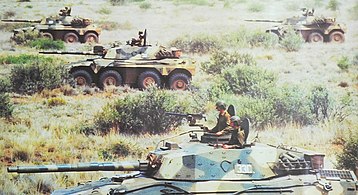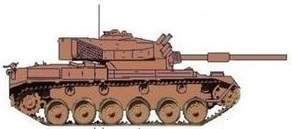
The South African Army is the principal land warfare force of South Africa, a part of the South African National Defence Force (SANDF), along with the South African Air Force, South African Navy and South African Military Health Service. The Army is commanded by the Chief of the Army, who is subordinate to the Chief of the SANDF.
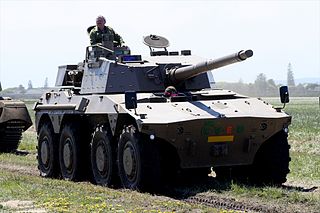
The Rooikat is a South African armoured reconnaissance vehicle equipped with a stabilised 76 mm high velocity gun for organic anti-tank and fire support purposes. The Rooikat's main armament was built with the Oto Melara 76 naval gun as its basis, to which it is nearly identical in terms of technical performance and statistics. The Rooikat can also fire the same ammunition as the naval gun, albeit modified with new percussion primers in the shells.

The black beret is a colour of beret, a type of headgear. It is commonly worn by paramilitaries and militaries around the world, particularly armored forces such as the British Army's Royal Tank Regiment (RTR), the Royal Canadian Armoured Corps (RCAC), and Royal Australian Armoured Corps (RAAC) and the Indian Army Armoured Corps and Indian Border Security Force. Notable non-armored military units to wear the black beret include the non-military police and non-special forces elements of the Irish Defence Forces, MOD Guard Service, Russian Naval Infantry and Russian OMON units, the United States Air Force (USAF) Tactical Air Control Party (TACP), Philippine National Police-Special Action Force (PNP-SAF) members, and the Royal Canadian Navy. It was also worn by the United Kingdom's Royal Observer Corps (ROC) with their Royal Air Force (RAF) uniform, Metropolitan Manila Development Authority (MMDA).
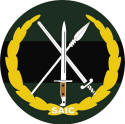
The South African Army Infantry Formation supervises all infantry within the South African Army.
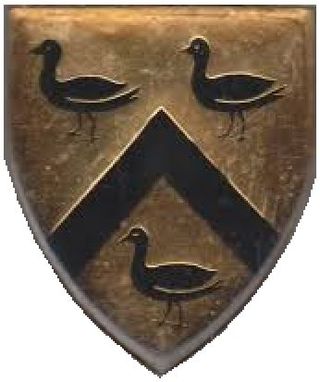
The Thaba Bosiu Armour Regiment is a reserve armoured regiment of the South African Army.

The Pretoria Armour Regiment is a reserve armoured regiment of the South African Army.

The General Jan Smuts Regiment is a reserve mechanised infantry regiment of the South African Army.

The Umvoti Mounted Rifles is an armoured regiment of the South African Army. As a reserve unit, it has a status roughly equivalent to that of a British Army Reserve or United States Army National Guard unit. It is part of the South African Army Armour Formation and is based in the town of Pinetown.

The Molapo Armour Regiment is a reserve armoured regiment of the South African Army.

The Blaauwberg Armoured Regiment is a reserve armoured regiment of the South African Army.

1 Special Service Battalion is an armoured regiment of the South African Army and only one of two such in its regular force. The Regiment is based at Tempe near Bloemfontein.

1 South African Tank Regiment is an armoured regiment of the South African Army, based at the Tempe military base in Bloemfontein as part of the South African Army Armour Formation.

The South African Army Engineer Formation is the controlling entity of all South African Army military engineering units. The Formation is currently commanded by the General Officer Commanding (GOC); Brigadier General D.W. Nkosi, as of early 2013.
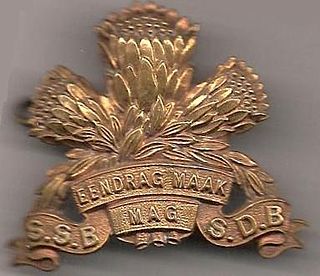
The Special Service Battalion (SSB) is a South African military unit formed on 1 May 1933 under the patronage of Oswald Pirow, Minister of Defence. The object was to give training to youths, between the ages of 17 and 23, who, in the wake of the 1929 depression, could find no suitable employment on leaving school.

The South African School of Armour is the training institute of the South African Armoured Corps located at Tempe, Bloemfontein.
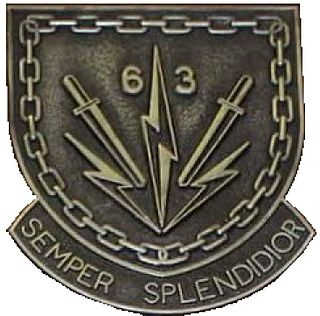
63 Mechanised Battalion Group was a unit of the South African Infantry Corps; although it was classed as mechanized infantry, it was a combined arms force consisting of infantry, armour and artillery. Together with 61 Mechanised Battalion Group and 62 Mechanised Battalion Group, these units made up 60 Brigade encompassing battlegroup principles.
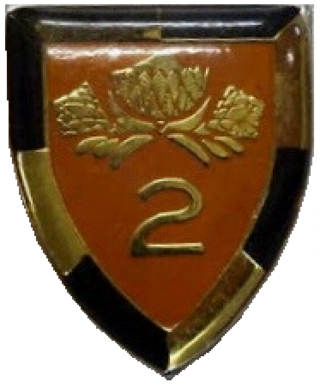
2 Special Service Battalion was an armoured regiment of the South African Army and only one of two such in its regular force. The Regiment was based at Zeerust. It was known in English as, 2 Special Service Battalion, and in the Afrikaans language as, 2 Spesiale Diens Bataljon.

Regiment Molopo was an armoured regiment of the South African Army. As a reserve unit, it had a status roughly equivalent to that of a British Army Reserve or United States Army National Guard unit.

81 Armoured Brigade was a Formation of 8th Armoured Division, a combined arms force consisting of armour, mechanised infantry, and mechanised artillery.





